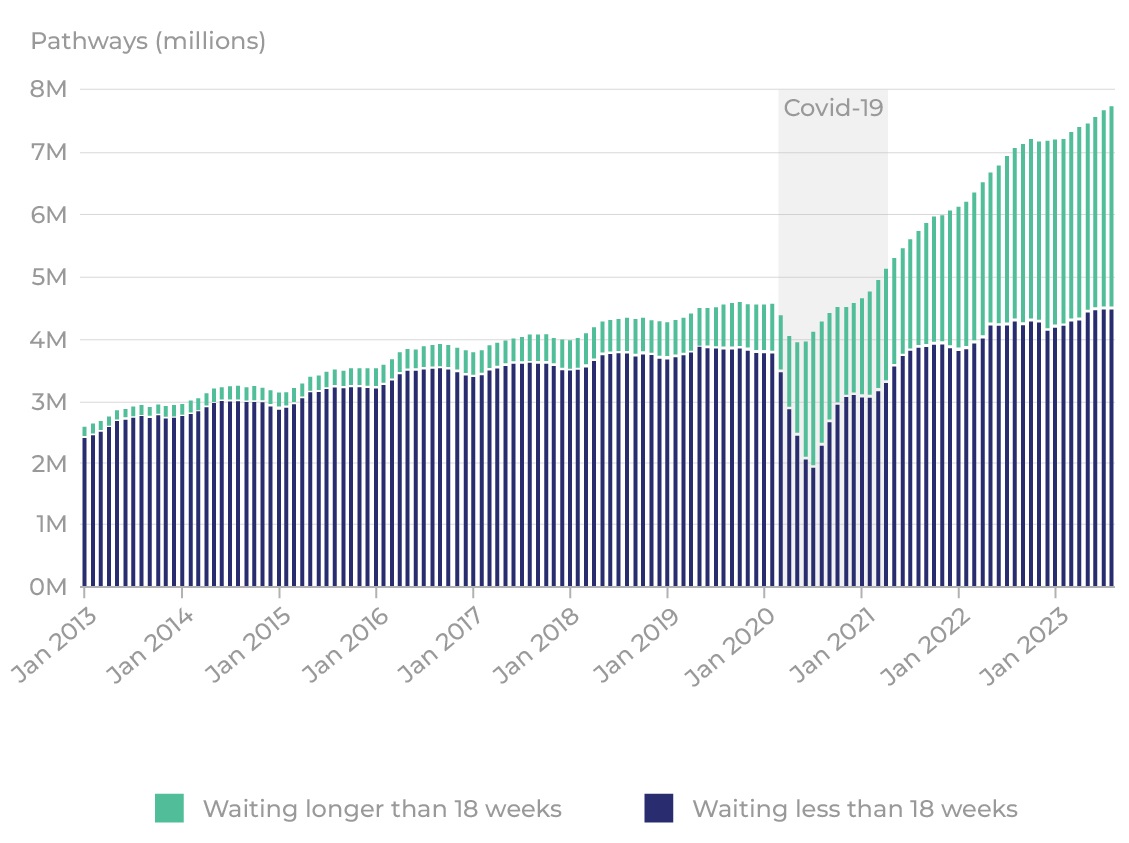
3 Key Ways to Reduce NHS Patient Waiting Times Safely & Efficiently
The gap between the high demand for healthcare services and the availability of Healthcare Professionals is as wide as it’s ever been – and it’s the reason why the need to reduce NHS patient waiting times is so prevalent.
It’s a widespread, endemic matter, and there are a variety of reasons why it’s such a struggle to bridge these gaps.
Addressing patient waiting times within the NHS requires a concerted effort grounded in collaboration, empathy, and a shared commitment to improving healthcare delivery. As we navigate this complex landscape together, it’s essential to understand the multifaceted challenges at hand and work collaboratively to find sustainable solutions that prioritise patient care.
Informed by over 20 years‘ experience in healthcare recruitment and with the delivery of a variety of cost-saving and service-improving solutions, ID Medical delivers proven methods for supporting the NHS in reducing patient waiting times safely and efficiently.
To give you some insight into how we achieve this with our clients, we’ve listed some of the key areas we focus on to achieve both immediate and long-term improvements.
What are current NHS patient waiting times like?
Why are patient waiting times so high?
Why is it important to reduce waiting times?
Methods for reducing patient waiting times in hospital
How ID Medical Can Help: Proven Strategies for Reducing Patient Wait Times
What are current NHS patient waiting times like?
The NHS waiting list has been growing since 2013 – almost tripling in size over the decade to 7.7 million.
The waiting list at large had already reached 4.6 million before the pandemic. During the height of Covid-19, the list grew sharply, due to the suspension of many forms of care.
Referral to treatment numbers have now returned to pre-pandemic levels, but they are growing at a faster rate than before; those who had to postpone treatment are now coming forward in their droves. Monthly treatments are also growing at a faster rate, but the number of treatments is not matching or exceeding the number of referrals – so waiting lists are still rising.

Why are patient waiting times so high?
The issue of patient waiting times within the NHS is not a new one but has become increasingly urgent in recent years. Decades of underfunding, resource shortages, and political pressures have created a scenario where meeting the demand for healthcare services is a persistent struggle.
The recent surge in waiting times, exacerbated by the COVID-19 pandemic, has further highlighted the need for comprehensive and collaborative approaches to address this issue.
Delays in accessing treatment can be frustrating for both patients and healthcare professionals. Multiple factors contribute to waiting times, including:
- Staff Shortages: The NHS requires a dedicated workforce to meet patient needs. However, current staffing levels can make it difficult to keep pace with demand.
- High Patient Demand: The population is growing and aging, leading to an increased need for healthcare services.
- Administrative Complexities: Lengthy referral processes and cumbersome paperwork can slow down the delivery of care.
- Limited Infrastructure: While the NHS strives to expand its capacity, there are constraints on physical space and available equipment.
It would be remiss to overlook the fact that waiting lists have been a part of the NHS service since its inception. Statistics on patients waiting for hospital treatment date back to 1949.
Reducing hospital waiting times has been a priority ever since it first became an issue. And sometimes, targets have been achieved. From 2008 to 2015, the 18-week ‘standard’ was consistently reached.
But a combination of recurring and consistent issues – as exampled in the above list – is the reason why that standard has not been able to be met since February 2016.
The list exceeded 3 million in February 2014. In February 2020, just before the pandemic arrived, the list had grown to over 4.5 million. Then, vast amounts of routine care was postponed to free up space for patients suffering with Covid-19. The waiting list swelled to 6.2 million by February 2022. Since then, the waiting list has continued to increase, as any opportunity to address the backlog has been hindered by financial restraints and operational pressures, including repeat strike action.
Why is it important to reduce waiting times?
Reducing patient waiting times within the NHS is a critical aspect of ensuring the overall health and wellbeing of individuals. From the moment a patient is referred by their GP for a specialist scan, test, or treatment, any delays they encounter can have consequences. These delays are not merely inconveniences; they can exacerbate conditions, lead to increased pain, and, in some cases, even contribute to worsened health outcomes.
Timely access to treatment not only prevents conditions from worsening but also allows Healthcare Professionals to intervene earlier, potentially mitigating long-term complications and reducing the overall burden on the healthcare system.

Methods for reducing patient waiting times in hospital
Reducing waiting times has been a longstanding priority for the NHS. Efforts have been made to streamline processes and implement new technologies. However, the ever-present demand for services requires ongoing innovation and collaboration.
In our pursuit of solutions to reduce patient waiting times, it’s essential to recognise the invaluable expertise and dedication of NHS Professionals who work tirelessly to deliver high-quality care to patients every day. At ID Medical, we strive to offer support and resources that complement and enhance the efforts of NHS trusts and their frontline Healthcare Professionals.
1. Increase hospital capacity
Investing in infrastructure and streamlining processes are essential steps in increasing hospital capacity and reducing bottlenecks in patient care pathways. By expanding facilities, optimising workflows, and leveraging innovative technologies, we can ensure that patients receive the care they need in a timely and efficient manner.
At ID Medical, our role is to provide additional resources, expertise, and support where needed, empowering NHS trusts to enhance their capacity and deliver high-quality care to patients.
We specialise in clinical services insourcing, offering additional resources for various specialties including Bowel Cancer Screening, Cardiology, Dermatology, and many more.
Our services are designed to help NHS trusts reduce patient waiting times safely and efficiently. We deliver millions of pounds worth of savings against NHS tariffs and are a CQC-regulated provider, ensuring high standards of care. Our insourced clinical services include rapid and remote deployment, flexible models designed around demand, cutting-edge diagnostics, robust clinical assurance, and 24/7 support service.
For example, our GP-led streaming services that have been integrated into ED offer a pioneering solution to address the challenges faced by emergency departments. By merging emergency care with primary care, our insourced GP team reduces patient wait times and improves access to care.
By leveraging our expertise and resources, trusts can increase hospital capacity and reduce patient waiting times to help improve the quality of care delivered to patients.
2. Embrace telemedicine
Telemedicine, also known as telehealth – the use of digital communication technologies to provide medical services remotely.
Embracing telemedicine has proven to significantly contribute towards the reduction of patient waiting times while ensuring safe and efficient healthcare delivery.
By leveraging digital communication technologies, we can facilitate virtual consultations, remote monitoring, and efficient triage, all of which contribute to a more streamlined and patient-centred healthcare experience.
ID Medical provides guidance, training, and support in implementing telemedicine solutions effectively, ensuring that patients can access the care they need, when they need it, regardless of geographic location or physical barriers.
We can support you with digital consultations, clinics and triage assessments through our workforce technology and managed workforce solutions.
Incorporating telemedicine presents a transformative opportunity to enhance access to care, improve patient outcomes, and mitigate the challenges associated with patient waiting times. With our support with leveraging digital technologies to deliver remote medical services, your resources can be optimised, patient satisfaction enhanced, and access to quality care made more timely.

3. Improve patient flow with workforce technology
Long patient waiting times are a frustrating experience for everyone involved. Advanced Workforce technology offers a range of solutions that can significantly improve patient flow, leading to shorter waits and a smoother overall experience.
By automating scheduling processes, improving communication between staff members, and optimising resource allocation, we can ensure that patients are seen promptly and receive the care they need without unnecessary delays.
At ID Medical, we provide comprehensive workforce technology solutions. They’re tailored to the unique needs of each NHS trust, to enhance efficiency, coordination, and patient satisfaction across the board.

Support from ID Medical: Proven Strategies for Reducing Patient Wait Times
Our teams are committed to supporting NHS trusts in their efforts to reduce patient waiting times and improve healthcare delivery.
We offer a range of proven strategies, solutions, and support services designed to address the unique challenges faced by individual Healthcare Organisations.
From clinical services to workforce technology and telemedicine, we provide comprehensive support every step of the way, empowering NHS trusts to deliver high-quality care to patients efficiently and effectively.
And we recognise that reducing patient wait times is not merely about meeting targets or fulfilling quotas; it’s about enhancing the health and wellbeing of individuals, saving lives, and delivering compassionate and efficient care to those who need it most.
By partnering with us, you can leverage our proven strategies to navigate the challenges of healthcare delivery and drive tangible improvements in patient access and satisfaction. Together, we can build a healthcare system that is not only efficient and effective but also equitable and compassionate.
Contact Us
If you’d like to learn more about ID Medical’s proven solutions
for reducing patient wait times, get in touch today.